The votes are in, and Architizer is thrilled to unveil the winners of the A+Product Awards! Register for Architizer's A+Product Awards Newsletter to receive future program updates.
Photovoltaics — also known as solar panels — are one of the most reliable methods for producing renewable energy in the world. Using an array of photovoltaic cells, these technologies absorb and convert sunlight into clean, usable electricity.
Whenever integrating photovoltaics into a project, one of the first step is determining the size of the system and how much of the building’s energy it will support. Therefore, it is important to talk to your manufacturer about where your project is located, how much sun it will receive and the overall electrical demand of the building. Some additional questions that you may want to ask yourself are whether you prefer a roof-mounted system or one that sits atop a shade structure or outbuilding as well as whether the cells should be made of monocrystalline, polycrystalline or amorphous silicon.
To help you select the right photovoltaic system for your next project, we’ve outlined the options available, together with some fundamental factors pertaining to aesthetics and performance that architects should consider.

Science Pyramid by BURKETTDESIGN with photovoltaics by Onyx Solar; Image via Archello
Photovoltaic Systems
Grid-Connected Systems: Grid-connected systems only operate when utility is available. Since utility outages are rare, these systems will usually provide the greatest amount of savings to the building owner. However, in the event of an outage, the system will shut down until utility power is restored. Components of a grid-connected system typically include:
- PV Module: This refers to environmentally sealed collections of PV Cells that convert sunlight to electricity; the most common PV module is 5 to 25-square-feet in size
- PV Array: A PV array is a collection of PV panels, which typically contains four or more PV modules attached together by struts. An array is a complete power-generating unit and is typically around 20 to 35-square-feet.
- Balance of System Equipment: This refers to the mounting and wiring systems that are used to integrate the solar modules into the structural and electrical systems of the home.
- DC-AC Inverter: This converts DC-power from the PV array into standard AC-power that is consumed by buildings. Its size is determined by the building’s electrical demand.
- Meters: Meters indicate how the system is performing and can provide information regarding the building’s energy usage.
Remote Systems: Remote systems incorporate energy storage in the form of batteries and can thus operate in the case of a utility outage. In addition to the components mentioned above, remote systems also include batteries, battery enclosures, battery charge controllers and separate subpanels for critical load circuits.

Solar panel installation via Evergreen Solar
Aesthetics
There are several options for mounting a PV system onto a building, as well as new opportunities for systems that are seamlessly integrated into the building’s components. For further visual inspiration, check out Architizer’s collection Catching Rays: 6 Phenomenal Photovoltaic Façades. Here are some of the most common options:
Rooftop: These PV systems integrate electricity-generating solar panels on the roof of building structures and are often some of the most convenient ways to integrate photovoltaics into a design. For angled roofs, the PV system may be mounted above and parallel to the roof surface with a standoff of several inches for cooling purposes. In cases of suboptimal angles or flat roofs, a separate structure may be employed to improve energy performance by optimizing the tilt-angle towards the sun.
When integrating rooftop PV products, it is important to talk to your manufacturer about the roofing materials that the building will involve. Heavier materials such as masonry, are often structurally designed to be near the limit of their weight-bearing capacity. In these cases, it may be necessary to transition to a lighter product, such as composite shingles, in areas where additional PV systems will be mounted.
Photovoltaic Shade Canopies: This option involves a partial or full integration of a PV array into a structure, such as a patio cover or deck shade. Expansive unobstructed spaces such as parking lots and other outdoor areas, are ideal for these types of systems. In general, however, this mounting type is a more costly option than roof mounting and can require more maintenance as they may be more prone to vegetation and vines growing on the modules and wiring.
Building Integrated Photovoltaics (BIPV): BIPVs displace some of the more conventional PV products with building-integrated modules, allowing for new and aesthetically pleasing ways of integrating energy-saving systems. Commercially available products include roof slates and standing seam metal roofing products.
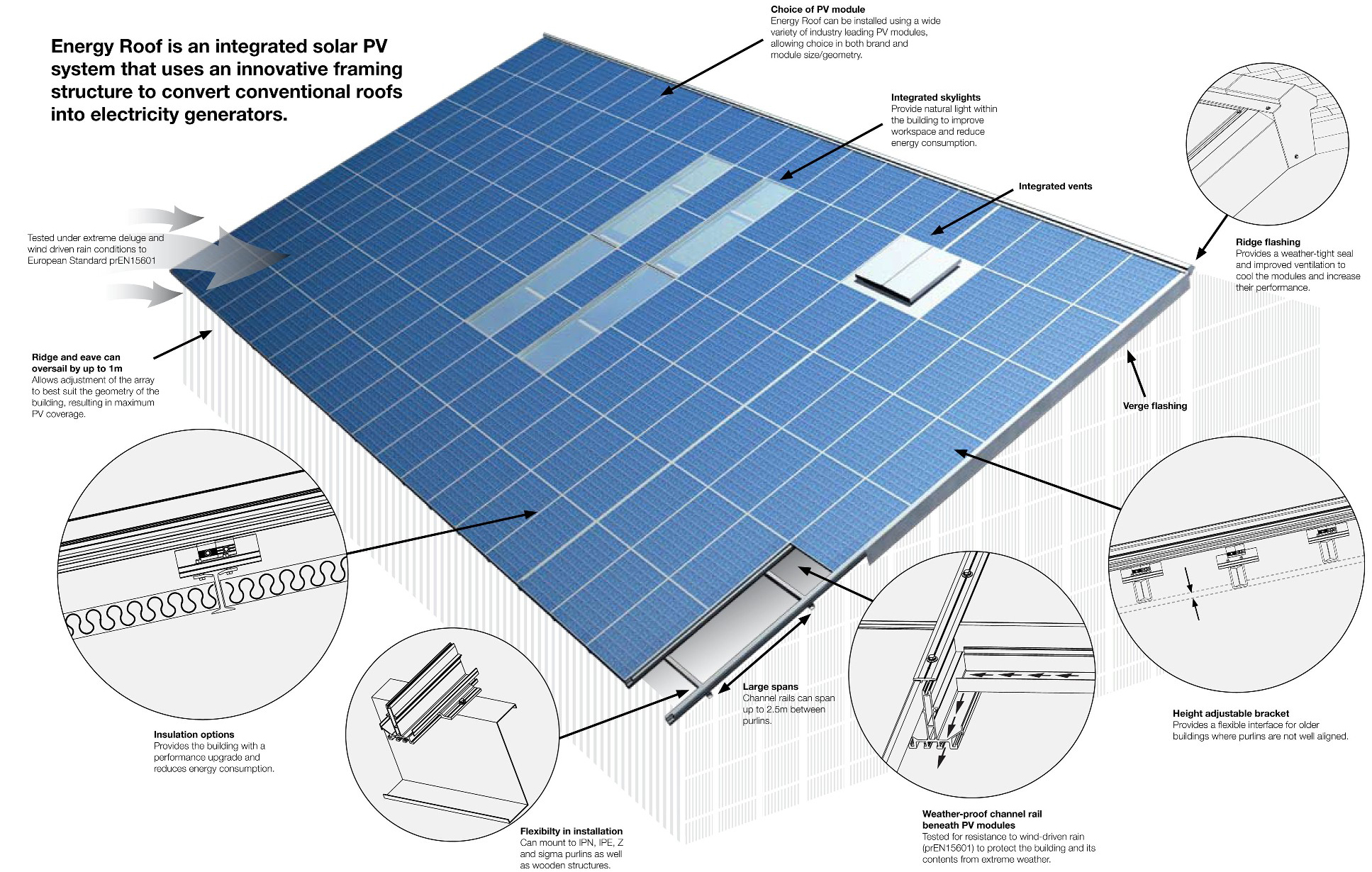
A typical example of a BIPV roofing system; via KOUKUUJINJA
Special attention must be paid to ensure that these products are installed properly, carry the necessary fire ratings and do not cause roof leaks. For more information on BIPVs, check out Architizer’s case studies: Behind the Design: How Solar Roof Tiles Really Work and How C.F. Møller Architects Altered the Face of Building-Integrated Solar Panels.
Backsheet: PV arrays can be matched to the roofing of a building by customizing the color of the module frame and backsheet. Modules with black frames and black back-sheets meld visually with a dark-colored roofing surface, while bronze frames may be a good match for clay roof tiles or brown-colored shingles or metal. Modules are also available framed or unframed.
Cell Color: Monocrystalline cells tend to be dark and matte, polycrystalline cells appear more sparkly and amorphous cells more translucent. Monocrystalline cells are also available in gold, magenta, steel blue and dark blue, although this type of color alteration usually results in lower energy efficiency, anywhere from 3 to 4-percent.
Search for Solar Panel Manufacturers
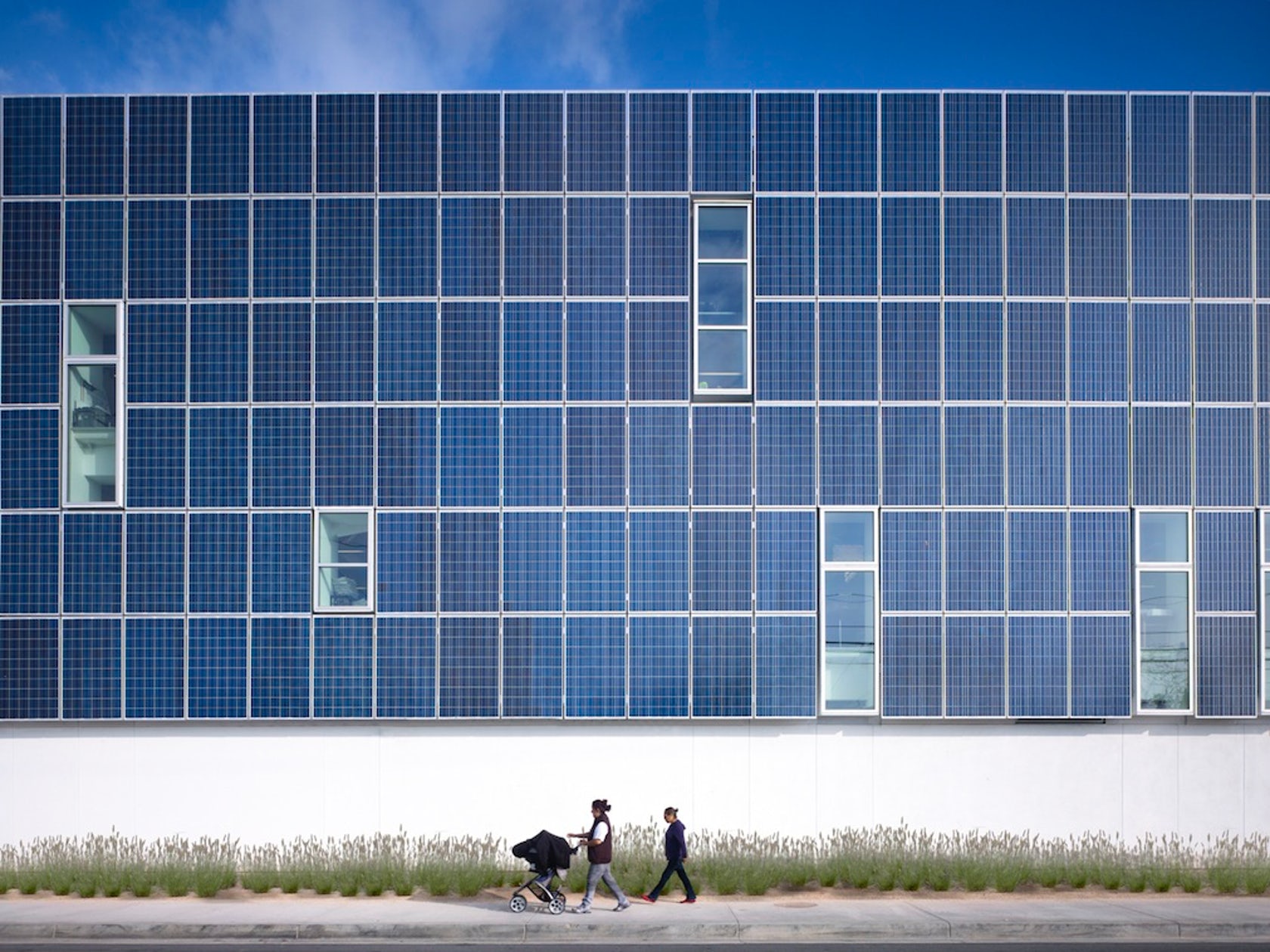
Green Dot Animo Leadership High School by Brooks + Scarpa Architects with photovoltaics by Sun Power
Performance
Material: PV modules are available in several materials and technologies, all of which vary in their levels of efficiency. Today, the three most common are monocrystalline, polycrystalline and thin film amorphous.
- Monocrystalline: Monocrystalline panels are the oldest, most developed and most expensive of the three technologies. Created from a continuous crystal structure, monocrystalline achieves the most efficient sunlight conversion rates, with efficiency averages from 15 to 20-percent.
- Polycrystalline: Over the past few years, polycrystalline has become the dominant technology for solar panels on the residential scale, due to their cheaper methods of production compared to monocrystalline. Despite being viewed as inferior in the past, polycrystalline cells now reach very similar levels of efficiency as monocrystalline cells.
- Thin Film Amorphous: Thin film panels involve a completely different technology to mono and polycrystalline panels. Less efficient, these systems occupy much more space to create the same amount of energy. One advantage is that thin film amorphous technology performs better in low light conditions, when there is partial shading of the system or when there is extreme heat. With current efficiency rates of around 9-percent, vast improvements in thin film technology are expected in the next ten years.
Building Orientation and Location: The orientation and geographic location of the building influence the amount of sunlight that can be captured by a PV system. Optimal locations are those that receive more sunshine, such as the Southwest United States, while the best orientation is south-facing with no obstructions such as vegetation or trees.

EWE & Bursagaz Headquarters by tago architects with photovoltaics by Onyx Solar
Electrical Demand: It is important to know the electricity demand of the building as well as the extent to which the PV system should cover this demand. If possible, provide a detailed layout to the PV manufacturer you are working with.
Size & Number of Modules: Most modules are typically rectangular and come in many sizes to accommodate the installation area. Be sure to state the length and width of the modules and if you are unsure of the sizing or total number, tell you manufacturer the area of the installation space and the total wattage of the system.
Maximum Power Output: The performance of PV modules and arrays are generally rated according to their maximum DC power output under Standard Test Conditions (STC). Since these conditions are not always indicative of how PV modules and arrays will operate in the field, it is important to recognize that performance after installation may only be 85 to 90-percent of the STC rating.
Tracking System: Low-cost mounting racks tend to be fixed however, you may also choose manual and automatic racks that track the sun throughout the day, in order to increase a system’s power output.
Case Studies
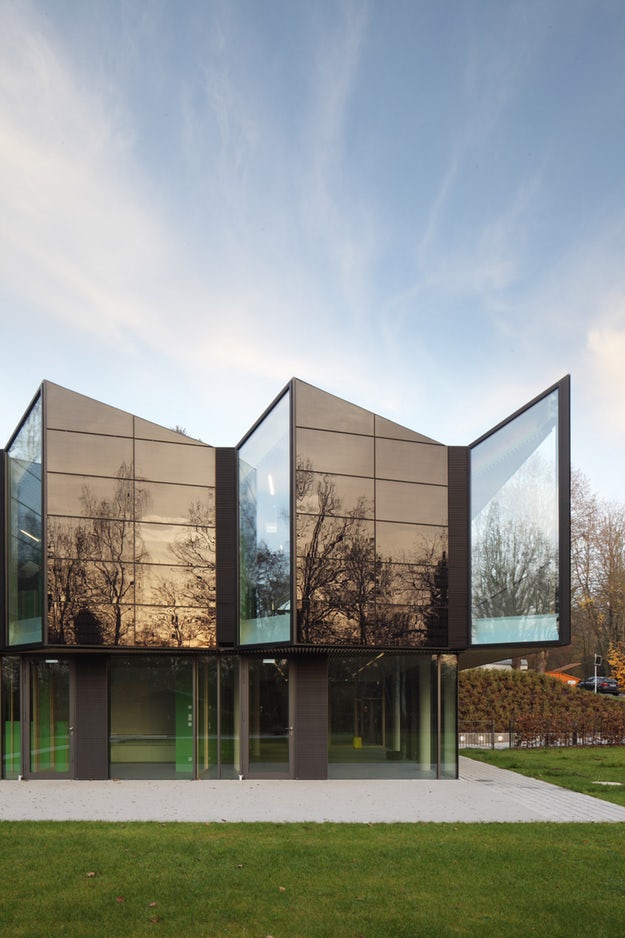
Nursery +e in Marburg by opus Architekten BDA; Photovoltaics by Ertex Solar
Catching Rays: 6 Phenomenal Photovoltaic Façades
Today, all that is changing with the invention of building integrated photovoltaics or BIPVs. This new breed of solar panel is incorporated directly into the building envelope. The sleek panels become an exciting new design element, proudly displayed for all to see. We also now have the technology to construct BIPV curtain walls, composed of transparent or semi-transparent photovoltaic glazing, which not only fill interiors with sunlight but harness it for electricity. Thanks to these innovations and the public’s growing appreciation for clean power, photovoltaic façades are finally having their moment in the sun.
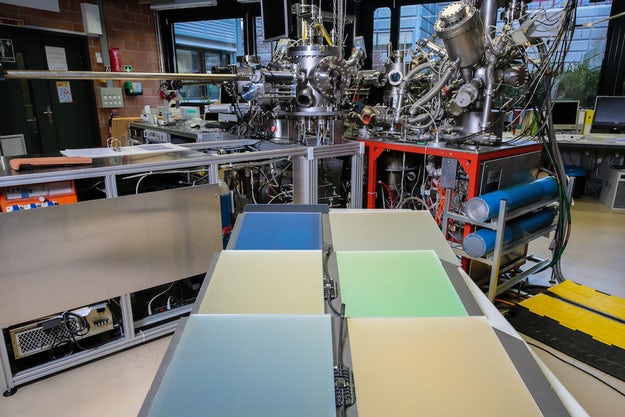
Solar glass panels created by the Ecole Polytechnique Federale in Lausanne; image via Lifegate
How C.F. Møller Architects Altered the Face of Building-Integrated Photovoltaics
The Copenhagen International School by C.F. Møller Architects is many wonderful things, but perhaps most remarkably, it is the architecture of willingness and foresight. With a façade encased in over 12,000 solar tiles, this project pushes well beyond carbon-neutrality while proving that a building can reject the dreary aesthetic that architects often associate with building-integrated photovoltaics. With deep pedagogical meaning, this school is not only a site of learning for the students within, but an indispensable resource for the wider world.
The votes are in, and Architizer is thrilled to unveil the winners of the A+Product Awards! Register for Architizer's A+Product Awards Newsletter to receive future program updates.
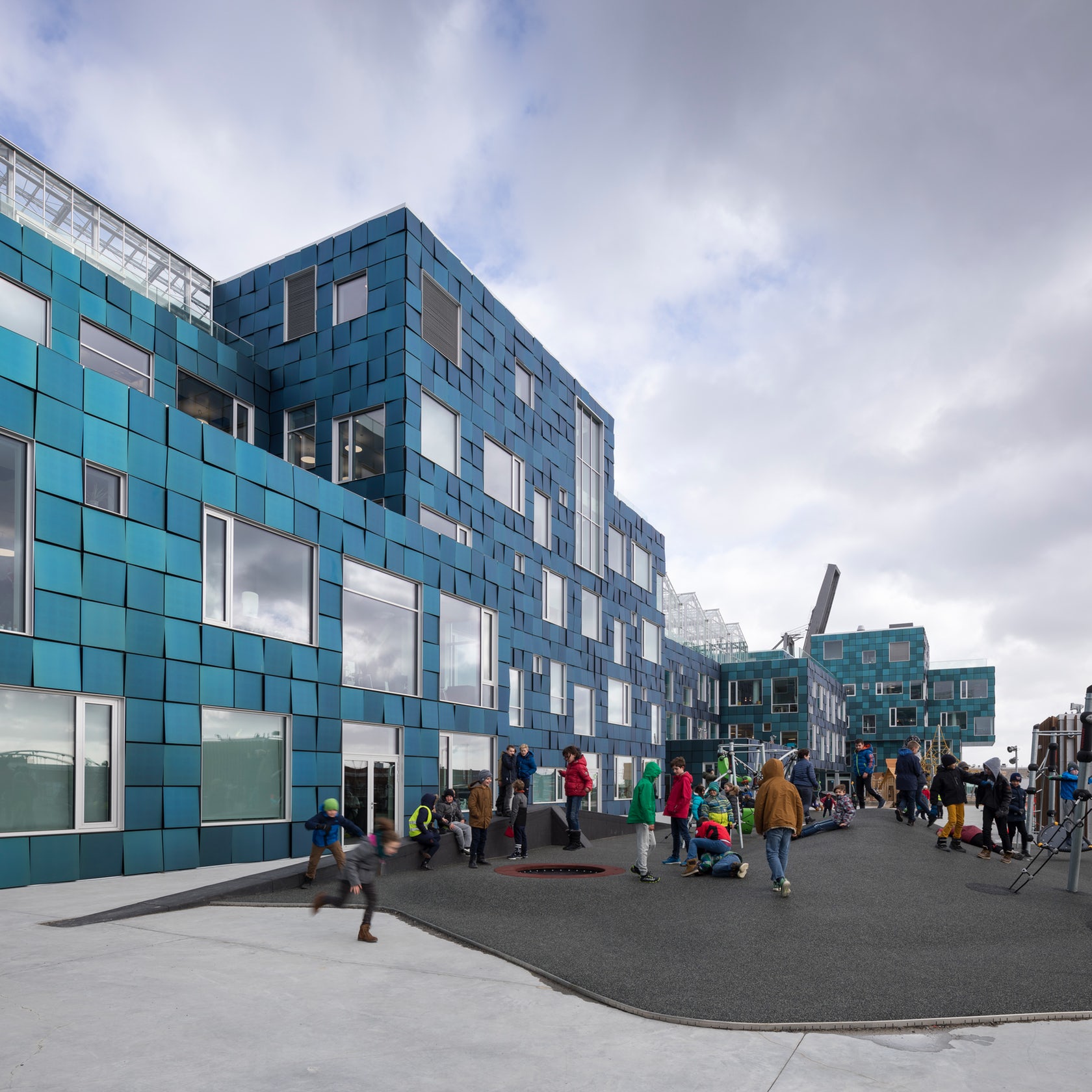





 Copenhagen International School Nordhavn
Copenhagen International School Nordhavn  EWE & Bursagaz Headquarters
EWE & Bursagaz Headquarters  Green Dot Animo Leadership High School
Green Dot Animo Leadership High School  Science Pyramid
Science Pyramid 


